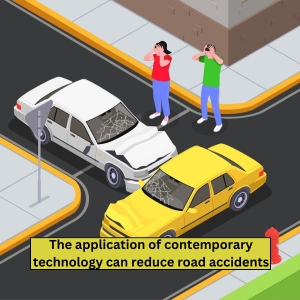The application of contemporary technology can reduce road accidentsPosted by Atul on October 21st, 2023  Introduction to how contemporary technology can reduce road accidentsWe will discuss an important aspect of road safety that can have a significant impact on our lives: the application of contemporary technology to reduce road accidents. Road accidents are a global problem that claims millions of lives each year and causes severe injuries. According to the World Health Organization, around 1.35 million people die in road accidents annually, making it one of the leading causes of death worldwide. The economic cost of these accidents is also staggering, with countries spending billions on emergency care, rehabilitation, and property damage. With such alarming statistics, it becomes imperative to address this issue and find ways to reduce the number of road accidents. This is where technological advancements in the transportation industry come into play. Over the years, there have been significant developments in transportation technology, from self-driving cars to advanced sensors and cameras. These innovations have not only made our commute more convenient but also have great potential in improving road safety. Technology can play a crucial role in reducing road accidents by addressing some common human errors and limitations while driving. For example, driver fatigue is one of the leading causes of road accidents. Similarly, driver assistance technologies such as lane departure warning systems, blindspot detection systems, and automatic emergency braking systems are becoming increasingly popular in modern vehicles. These technologies use cameras and sensors to monitor the vehicle's surroundings and warn drivers if they are about to collide with another vehicle or object. Understanding Road Accidents and their ConsequencesIt's no secret that road accidents can have devastating consequences, both for the individuals involved and their loved ones. From minor fender benders to fatal crashes, these incidents can happen at any time and have a significant impact on our lives. That's why it's essential to understand road accidents and their consequences. But what exactly is contemporary technology? In simple terms, it refers to modern day advancements and innovations in various fields such as science, engineering, and medicine. These technologies are continuously evolving and have practical applications that make our lives easier and safer. And when it comes to reducing road accidents, contemporary technology plays a crucial role. With the rise of smart devices and intelligent systems, contemporary technology has transformed how we travel on roads. These advancements have enabled us to develop better safety measures that can potentially save countless lives every day. For example, many cars now come equipped with advanced driver assistance systems such as lane departure warning, collision avoidance systems, and automatic emergency braking. Another prime example of contemporary technology used for road safety is GPS tracking systems. These systems not only help us navigate unfamiliar routes but also enable authorities to monitor traffic patterns in real time. This allows them to identify areas with high accident rates and implement appropriate measures like speed limit changes or additional signage. The benefits of using contemporary technology for road safety are undeniable. Apart from preventing potential accidents from occurring, these technologies also contribute to better traffic management and smoother journeys for all. Current Technological Interventions to Reduce Road AccidentsRoad accidents have been a major concern for decades and continue to be a leading cause of death worldwide. According to the World Health Organization, approximately 1.35 million people die each year in road accidents, with another 2050 million sustaining nonfatal injuries. The need for reducing these numbers has led to technological advancements in the automotive industry, with a focus on safety measures. Automated Emergency Braking Systems:One of the key interventions in preventing road accidents is the use of Automated Emergency Braking (AEB) systems. These systems use sensors and cameras to detect potential collisions and automatically apply brakes if the driver fails to respond in time. This technology has shown promising results in avoiding rear end crashes and reducing their severity by up to 40%. A study conducted by the Insurance Institute for Highway Safety found that vehicles equipped with AEB had a 56% lower rate of rear end crashes compared to those without this system. Lane Departure Warning Systems:Another significant cause of road accidents is lane departures, where drivers unintentionally veer out of their designated lanes. Lane Departure Warning (LDW) systems use cameras or sensors to detect lane markings and alert drivers if they are drifting out of their lane without using turn signals. This technology can prevent headon or sideswipe collisions caused by unintended lane departures. Studies have shown that LDW systems can reduce single vehicle nighttime crashes by up to 49%. Advancements in Vehicle Communication TechnologiesAdvancements in Vehicle Communication Technologies for a Safer FutureTechnology has changed the way we live, work, and travel. And one of the most exciting advancements in recent years is in the world of transportation. With the rise of smart vehicles and intelligent transportation systems, we are seeing a shift towards a safer and more efficient future on our roads. Vehicle to Vehicle Communication (V2V):Imagine if your car could communicate with other cars on the road to share information such as speed, location, and potential hazards. This is made possible by V2V communication. Through wireless technology, vehicles can send and receive data in realtime to help drivers become aware of potential collisions or dangerous situations ahead. This technology has been proven to reduce accidents by providing drivers with an extra layer of safety and awareness on the road. Vehicle to Infrastructure Communication (V2I):While V2V focuses on communication between vehicles, V2I focuses on communication between vehicles and infrastructure such as traffic signals or road signs. Through this technology, vehicles can receive information about upcoming traffic lights, roadwork or accidents ahead, weather conditions or other important updates that may affect their journey. Check Out:Best Data Science Courses In India
Like it? Share it!More by this author |


